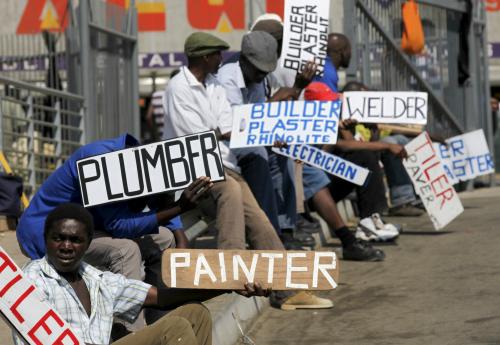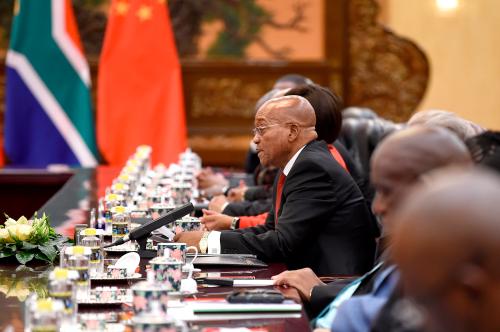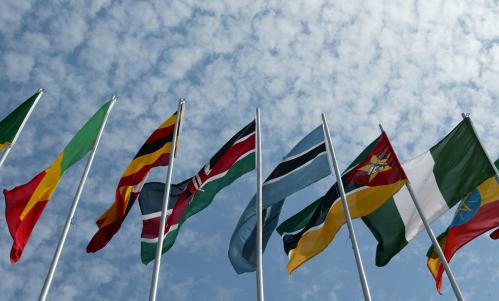Last week, the Africa Growth Initiative at Brookings hosted an event with South African Finance Minister Pravin Gordhan. The goal of the forum was to explore ways to support inclusive growth in South Africa, where unemployment stands at nearly 25 percent.
After the forum, I discussed these issues with Haroon Bhorat, director of the South African think tank the Development Policy Research Unit. Below are Haroon’s answers to my questions. The DPRU, a partner think tank of the Africa Growth Initiative, is a great resource on employment and inequality in South Africa and across the region. Read more about the DPRU on their Web site and also follow them on Facebook.
Julius Agbor: During his recent visit to Brookings, the South African Finance Minister, Honorable Pravin Gordhan, underscored the challenges of inclusive growth in South Africa. In order of importance, what are these challenges and do you think they are surmountable in the short term?
Haroon Bhorat: The key challenges revolve around an insufficiently high level of economic growth and the extreme levels of income inequality and unemployment: South Africa has one of the highest levels of inequality in the world, and, in the sample of emerging markets, possibly the highest. The Gini coefficient for South Africa is currently 0.66. Unemployment, using the International Labor Organization’s definition of joblessness, currently stands at about 25 percent for the fourth quarter of 2012. Following the Great Recession where close to 1 million jobs were lost in South Africa and in an environment where economic growth has yet to breach the 3 percent level, solving these twin distributional problems in the short run will be extremely difficult.
This new growth path would necessarily require both a signficant increase in the levels of economic growth and a sharp departure from the current growth trajectory. The current trajectory is based on a dependence on heavy manufacturing, the resources sector and foreign equity to finance the current account deficit, while the retail sector is the key provider of long-run employment. Obviously, this deficit-financed, consumption growth model is not an optimal strategy for long-run welfare gains in South Africa.
Agbor: South Africa’s current macroeconomic fundamentals and microeconomic framework leave much to be desired. For instance, the yield on a South African 10-year government bond is at a record high of 6.2 percent while the high incidence of HIV/AIDS coupled with an acute shortage of skilled man-power is seriously undermining both the productive potential of the economy and its ability to attract foreign investors. Do you think that the South African government needs to respond differently to these challenges? If so, how would you recommend it respond?
Bhorat: Foreign investors, both in equity markets and in the real economy, are concerned in part about social instability in a society borne out of high levels of crime, unemployment and inequality. In addition, a vocal, strong trade union movement viewed as politically influential as well as a signficant skills constraint have caused foreign investors to remain coy about South Africa. On the other hand, those who have invested or are invested in the economy often note South Africa’s strong rule of law, globally leading financial sector, and transport and telecommunication infrastructure which rivals that found in the West. In turn, high dividend streams with a relatively high real interest rate differential keep foreign investors interested in South Africa. In the short-run then, these strong companies and other South African endowments will keep foreign investors interested in the economy. In the long-run, however, a more creative growth trajectory and policy environment is required from government. We need a strategy and an environment that makes those difficult decisions in order to shift the economy on to a more labor-intensive and competitive growth path. Supply- and demand-side policies ranging from improving the quality of schooling to anti-trust interventions are all necessary.
Agbor: For quite a while now, low wages seem to characterize South Africa’s labor market, which is consistent with the high level of unemployment in the country. At the same time, there is no evidence of marked improvements in labor productivity and competitiveness of the South African economy. What is going on in South Africa?
Bhorat: We are in a low-level equilibrium trap of tepid growth and signficant labor disequilibrium in the factor and product markets. Certainly a more competitive wage environment, as well as more deregulated product markets, must be part of the answer. Bold industrial policy that is narrowed to very specific sectors and provides some form of infant industry protection is essential. No country has managed to build prosperity without the growth of the light manufacturing sector—and South Africa will be no different. Building a light manufacturing sector will be critical to generating the levels of employment this economy desperately requires.
Agbor: Many believe that anti-trust legislation is weakly enforced in South Africa and that corporate bodies and unions are too strong. To what extent do you think a rebound of the South African economy depends on reforms in these key areas?
Bhorat: There is a view that strong business and strong labor are able to divide the rents from growth in some semi-consensual form. That view then extends to the notion that this situation has generated a growth path built essentially on high dividends and high wages to the exclusion of the unemployed. This is obviously an undesirable outcome yet the solution does not necessarily lie in lower wages, which would generate the kind of social instability South Africa cannot afford. Rather, an acceptable outcome would come from a conscious effort by the South African government at generating creative solutions that include the unemployed and those in the informal economy into the growth process.
Presently a social compact is assured through a highly redistributive state. Hence, this government spending on social assistance constitutes 10.4 percent of total expenditure and 3.4 percent of GDP, which is high by middle-income country standards. This is not fiscally sustainable nor incentive compatible with the requirements of a competitive developing country economy. Hence, a key part of the reform package is not only more aggressive anti-trust legislation, but also interventions designed to improve the opportunities and capabilities of the informal economy as well as the unemployed. These can range from re-engineering state procurement policies to reducing the search costs of the unemployed.
Agbor: Does South Africa have a particular economic role to play in Africa? Is it a faciliator of investment in the region and beyond?
Bhorat: As Africa’s largest economy, South Africa remains central to the region and the continent’s future. That being said, Africa’s largest economy remains locked into a low-growth trap within a continent with some of the world’s fastest growing economies. South Africa’s short-run opportunity is to utilize its strong physical, financial and telecommunication infrastructure as a platform to attract foreign firms seeking a foothold in Africa. The 20 percent purchase by the Industrial and Commercial Bank of China of Standard Bank of South Africa in 2008 is indicative of this type of indirect impact the growth of African economies is having on South Africa.
That being said, South African firms are dominant in retail, mining and telecommuncations on the continent. The long-run growth question is whether these companies are able to capitalize on their early mover advantage and become the dominant investors in a region where FDI flows from China, India, Malaysia and other emerging markets are expanding rapidly.
The Brookings Institution is committed to quality, independence, and impact.
We are supported by a diverse array of funders. In line with our values and policies, each Brookings publication represents the sole views of its author(s).






Commentary
Africa Answers: Five Questions about Sustainable Inclusive Growth in South Africa
April 23, 2013